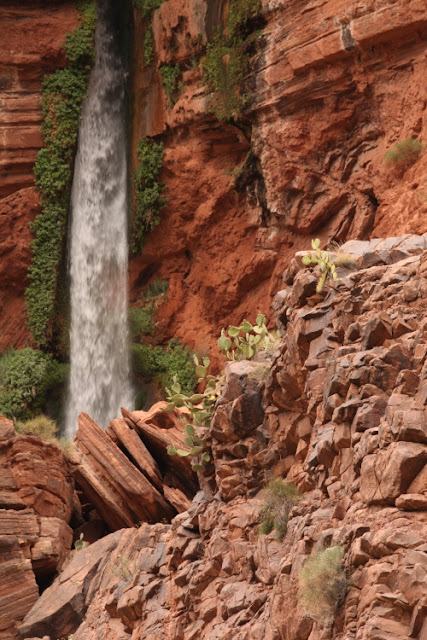The damp conditions precluded our scenic flight to the put-in so we drove and hiked in on the Mineral Bottom road. These switchbacks were recently rebuilt after a massive slope failure in the section seen here. See images of the wash-out here.
Things started out sunny on the walk down...
...but by the time we reached the river it was spitting rain. We never got a heavy rain - only drizzles.
The scenic Green River at the head of Stillwater Canyon. In the background, a slope of the Moenkopi and Chinle formations supports a cliff of Wingate Sandstone and Kayenta Formation.
Starting out for the 51 miles of Stillwater Canyon
Passing Upheaval Canyon with Upheaval Dome in the background. The dome has long been en enigmatic structure in the Park but more recent evidence suggests it formed from a meteor impact some 60 million years ago (in strata now eroded). Perhaps salts beds beneath this structure accentuated the doming effect but a purely salt diapir origin is now discounted as impact evidence has been found here.
Beds of the Moenkopi Formation along the Green River
Our first nights camp at Fort Bottom. The geologic map is out and we can see what layers are yet to come!
Late afternoon light on the cottonwoods from Fort Bottom
The rock units slowly rise above the river level, exposing older and older rocks as we run downstream. Here the Permian White Rim Sandstone emerges from beneath the river.
The Buttes of the Cross named by John Wesley Powell. They are actually two buttes seperated by about 1/2 mile but appear to form a cross from this vantage along the river above Anderson Bottom.
We hiked up to the top of the White Rim on an old cattle trail to view the outer canyon. The cross-bedding in the White Rim Sandstone was quite evident and dipped generally to the southeast.
A block of the White Rim Sandstone than collapsed next to the river was cleaved when it his the floor of the canyon.
The next layer in the sequence in the Cutler undivided section. See a short description here of this package of rocks. I have been scratching my head for years about these sand bodies exposed along the river. On the bottom, they are obviously river channels cut into the underlying strata. But how a lens shaped body of sand was then preserved beneath arch-up strata is curious to me. How could this have formed? Any suggestions?
Wide angle view from the mouth of Deadhorse Canyon
Closer view from the same locale. The Candlestick is on the left with the Turks Head on the right.
A collared lizard poses on the rocks
Remote Skylight Arch (or window)
An old cowboy camp in Canyonlands
A final view of Stillwater Canyon near river mile 7
A group of hearty hikers above Stillwater Canyon
The junction of the Green River (left) and the Grand River (right). The state of Colorado petitioned a government agency in 1922 to change the name of the Grand River to the Colorado River. I like the sound of "the junction of the Green and the Grand" too much to give up the old name. Bring back the Grand River!
Historic inscription at the confluence of the Green and the Grand:
STA SA 89+50
D. C.C. & P. R.R.
May 4, 1889
The Denver and Colorado Canyons & Pacific Railroad was the brainchild of Frank M. Brown of Denver, who wanted to ship Colorado coal to California via a railroad that would follow the Colorado River. Brown lost his life in Soap Creek Rapid in Grand Canyon two months after this inscription was made.
Hiking up to the Doll House in the Cedar Mesa Sandstone
Hanging out inside the rocks!
A slot canyon in the Cedar Mesa Sandstone with cross-bedding pointing the way
From up here we can see the Grabens, down-dropped valleys formed by faulting. The patch of light colored rocks (center left) used to be attached to the rocks in the foreground. But when Cataract Canyon was carved out, the far block slipped into the canyon as it was detached from the nearby cliff.
Spanish Bottom with the Colorado River flowing south toward the photgrapher
Fossil crinoids within the Honaker Trail Formation in Cataract Canyon
Capsize Rapid in Cataract Canyon
The rapid received its name when a group flipped a boat here in 1891. A historic inscription marks the event.
Big Drop 2 on the Colorado River
Johnny bringing his raft into Big Drop 3
The river was running between 25,000 and 30,000 cfs and so the waves were huge!
That's the Lake Powell formation on the right next to the river. When Lake Powell was full, the sediment from the river dropped out and inundated many rapids. This trip finished near Hite on the Colorado River, where we were met by our scenic airplane pilots to take us back over the rivers we had run.
Flying back to Moab, we looked down to see the confluence of the Green (light color) and the Grand (darker color).
Looking down at the Green River and the Turks Head
The Fisher Towers near Moab. Please join me on one of my exciting geology rafting trips!








































































